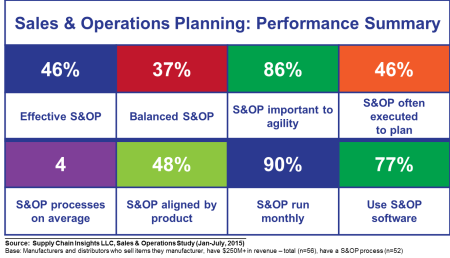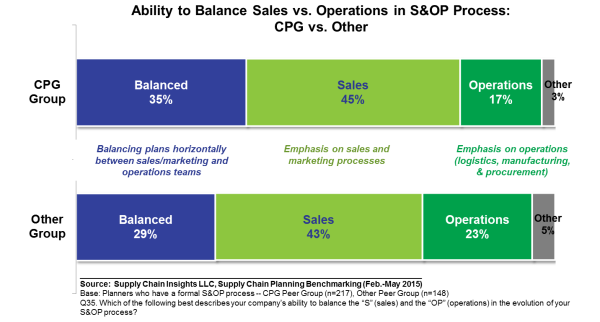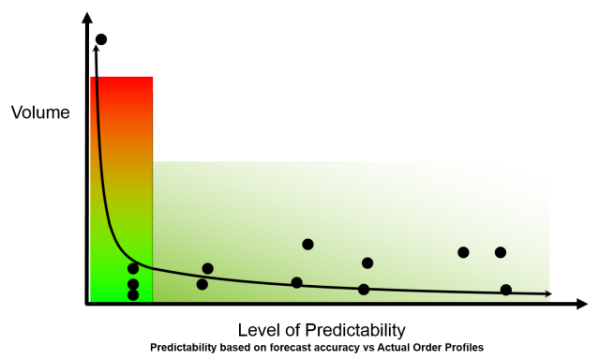Definition of a Mistake: An action or judgment that is misguided or wrong. Synonyms: Error, fault, blunder, oversight, miscalculation or a misunderstanding.
 Sales and Operations Planning (S&OP) is important to building value chain agility and improving enterprise performance. (Agility is the ability to have the same performance in cost, quality, and customer service given a level of demand and supply volatility.) Most processes are over 15 years old; yet, only 46% of companies feel their processes are effective.
Sales and Operations Planning (S&OP) is important to building value chain agility and improving enterprise performance. (Agility is the ability to have the same performance in cost, quality, and customer service given a level of demand and supply volatility.) Most processes are over 15 years old; yet, only 46% of companies feel their processes are effective.
The building of an effective S&OP process takes many years: often three to seven. Like a marriage, it requires continuous readjustment and renewal. The journey is hard work; and it is too important to incur a mistake, or experience a setback.
I see more and more companies making these seven common mistakes. Here I share these to help you and your team sidestep the issues to drive success.
1) Right Reporting Relationships. The most effective S&OP process reports to a profit-center manager (P&L). A P&L leader is the only person in the organization that can drive the right balance in trade-offs between commercial and operations considerations. Without this reporting relationship, it is very difficult to achieve balance.
Success does not happen overnight. The problem is that few P&L leaders understand supply chain planning. As shown in Figure 1, the maturity of S&OP is dependent on training the P&L leader on S&OP planning basics. Don’t assume that the basics are well-understood by the P&L leader.
Figure 1. Leadership Understanding of S&OP Planning Basics

2) Lack of Balance in Process Definition. Balance is more readily achieved when the reporting is to a P&L manager, but requires equal emphasis on both the operations and commercial processes. As shown in Figure 2, most companies are out of balance. Consumer Packaged Goods companies are more balanced than Food and Beverage.
Figure 2. S&OP Process Balance

3) Building the Right Team. Good planning drives better decisions. To be effective, companies need to build the right team. It requires a balance of junior and senior talent. When there are too many junior team members, the organization does not have enough institutional knowledge to formulate great plans. Similarly, when the planning organization is too mature, it is inflexible. In a conversation last week with supply chain leaders, in reviewing the chart in Figure 3, they emphasized that successful planning requires a team of both junior and senior planners. It needs a career path. The role should never be an entry-level turnover position or a senior role where there is little change.
Additionally, to keep planning teams and mitigate turnover, planning salaries are often too low. Invest in benchmarking salary comparable(s) for your region. Aim to pay in the 80% percentile or higher to retain and keep talent.
Figure 3. Years in Planning Positions

Structure the role to give planners time to plan. In the design of the role, ensure that there is a focus on the important not just the urgent. When planners are always reacting to issues, they never get time to plan. Likewise, if the planners are always in meetings, they will not have time to plan. In a recent study of planners, we found that the average planner spends 20% of their time planning and using the technologies.
4) Attention to Detail in Forecasting Processes. In the modeling of demand, many companies track demand error as part of continuous improvement programs. The measurement of a Weighted Mean Absolute Percent Error (WMAPE) looks like a better number than a non-weighted MAPE (Mean Absolute Percent Error), the measurement of MAPE and a focus on reducing error of products in the tail, will improve customer service.
To measure the tail, chart volume versus demand predictability or order frequency. The products on the tail are the most difficult to forecast, and are also the most important to get right to manage costs and supply chain cycles.
Figure 4. The Long Tail of the Supply Chain

Additionally, avoid these common mistakes in forecasting:
- Introduction of Bias and Error in Consensus Forecasting. Manage Input. Consensus forecasting can often degrade forecasting accuracy. Track the effectiveness of managerial overrides. In a recent study, we found two companies were more accurate on lag 3 and lag 4, and less accurate on lag 1 due to the introduction of error through consensus forecasting.
- Thinking That the Forecast Cannot Be Improved. Drive Continuous Improvement. Measure forecast accuracy against the naive forecast (a forecast based on shipments in the prior period). Drive continuous improvement by holding the demand planners responsible to drive value in forecasting against the naive forecast.
- The Hoax of One-Number Forecasting. While many consultants will recommend the adoption of one-number forecasting, focus on a common plan, not one number. A forecasting plan is more sophisticated than one number. The forecast has the ability to roll-up and roll-down a hierarchy. Focus the effort on improving the forecast of the item, or SKU.
5) Ability to Model a Feasible Supply Plan. While the scores of demand planning are lower on user satisfaction than those of demand, the range of acceptance of supply systems is larger. Few companies, i.e. 25%, have the ability to model a feasible plan, and only 33% can model what-if conditions for supply. While it is tempting for teams to focus on visualization technologies like Anaplan, O9, SAP IBP and Steelwedge, be sure that the planners have the ability to model an effective supply plan. This includes the modeling of supply constraints and the measurement of impact of shifts in multi-tier planning. This is a fundamental building block of a successful S&OP program.
Figure 5. Effectiveness of Demand vs. Supply

6) Tight Integration of the Financial Budget. One of the biggest mistakes is tight coupling of the financial budget to the S&OP plan. Work hard with the financial team to ensure alignment. Use the budget as an input into the S&OP plan, but never constrain the plan by the budget if the goal is to maximize revenue and profit.
Figure 6. Change Management Barriers to S&OP

7. Not Connecting S&OP Planning to Execution. Don’t plan in isolation. Instead, build playbooks to enable the connection of the plan to better execution. Only one in three companies are successful in connecting S&OP planning to execution. Do this by building the playbooks based on “what-if” analysis and reviewing and realigning the plan weekly.
These are the seven mistakes that we see the most frequently. What do you think? Did we miss any? We would love to hear from you.
____________________
Life is busy at Supply Chain Insights. We are working on the completion of our new game—SCI Impact!—for the public training in Philadelphia in August and the content for the Supply Chain Insights  Global Summit in September. Our goal is to help supply chain visionaries, around the world, break the mold and drive higher levels of financial improvement. The conference will feature case studies on supply chain transformation, digital transformation and insights from supply chain leaders on the Supply Chain to Admire analysis. We find that companies that have reached better alignment with their financial teams have higher levels of financial results.
Global Summit in September. Our goal is to help supply chain visionaries, around the world, break the mold and drive higher levels of financial improvement. The conference will feature case studies on supply chain transformation, digital transformation and insights from supply chain leaders on the Supply Chain to Admire analysis. We find that companies that have reached better alignment with their financial teams have higher levels of financial results.
About the Author:
 Lora Cecere is the Founder of Supply Chain Insights. She is trying to redefine the industry analyst model to make it friendlier and more useful for supply chain leaders. Lora has written the books Supply Chain Metrics That Matter and Bricks Matter, and is currently working on her third book, Leadership Matters. She also actively blogs on her Supply Chain Insights website, at the Supply Chain Shaman blog, and for Forbes. When not writing or running her company, Lora is training for a triathlon, taking classes for her DBA degree in research, knitting and quilting for her new granddaughter, and doing tendu (s) and Dégagé (s) to dome her feet for pointe work at the ballet barre. Lora thinks that we are never too old to learn or to push an organization harder to improve performance.
Lora Cecere is the Founder of Supply Chain Insights. She is trying to redefine the industry analyst model to make it friendlier and more useful for supply chain leaders. Lora has written the books Supply Chain Metrics That Matter and Bricks Matter, and is currently working on her third book, Leadership Matters. She also actively blogs on her Supply Chain Insights website, at the Supply Chain Shaman blog, and for Forbes. When not writing or running her company, Lora is training for a triathlon, taking classes for her DBA degree in research, knitting and quilting for her new granddaughter, and doing tendu (s) and Dégagé (s) to dome her feet for pointe work at the ballet barre. Lora thinks that we are never too old to learn or to push an organization harder to improve performance.







